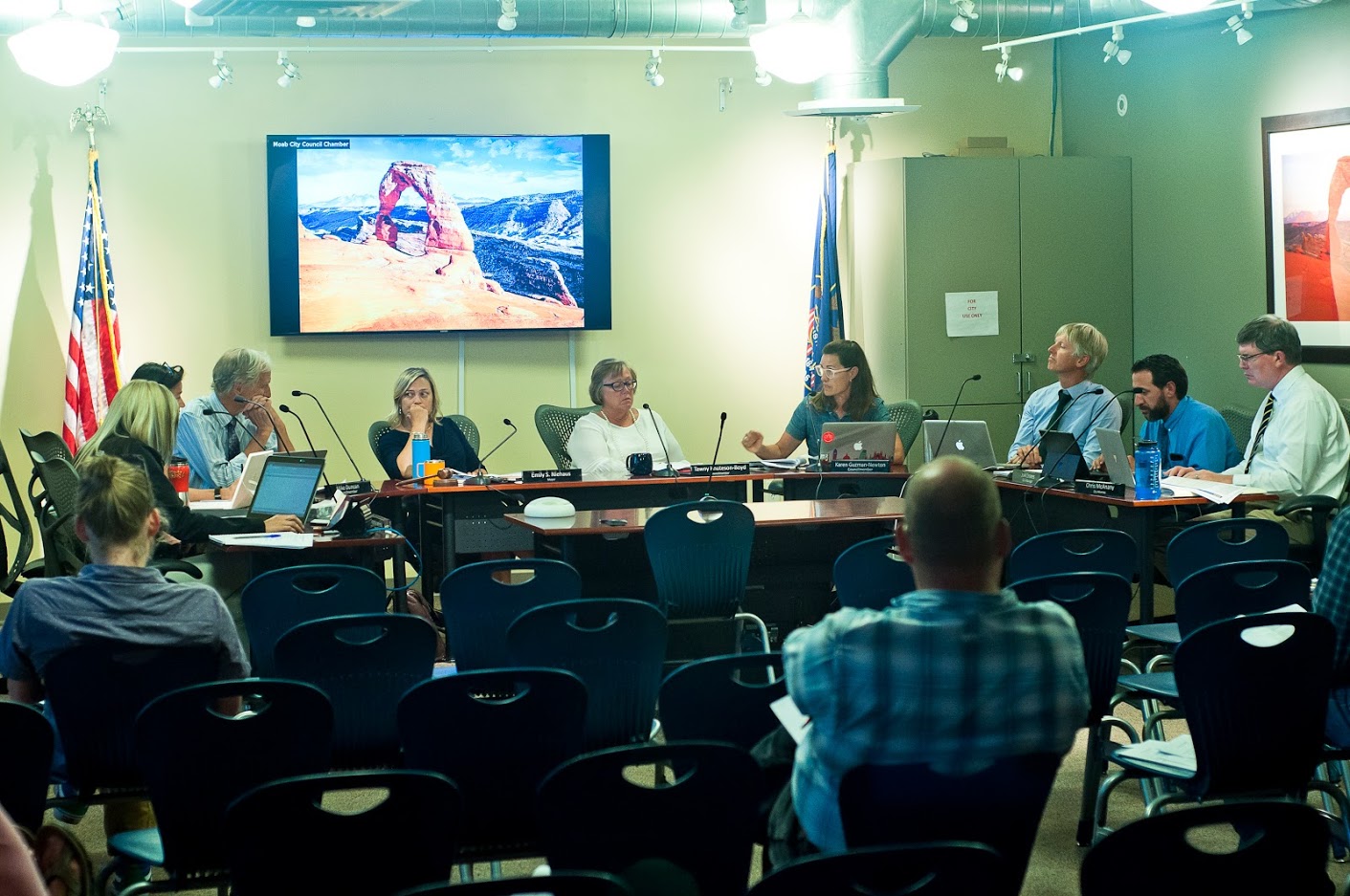Some information may be outdated.
The Moab City Council is racing the clock.
Enacted in February, the 180-day moratorium halting new overnight accommodations from being planned for Moab’s commercial and residential districts will expire on Aug. 12.
The council had voted 4-0 to take this building hiatus so the city could research and contextualize the effects the new accommodations could have on Moab’s short- and longterm economic health.
What specifically has been done during this pause on overnight rentals?
For this past six months, the city’s planning commission and council have met numerous times during the growth hiatus, jointly assessing and discussing this topic against the existing zoning in Moab. Public meetings, work sessions and focus groups have aimed to identify and assess the strengths, weaknesses, opportunities and threats that could arise for Moab over time.
During its June 25 meeting, Moab City Planner Nora Shepard told the council that these findings have resulted in Draft Ordinance 2019-18, which modifies the city codes for its six zones (C1, C2, C3, C4, RC and SAR).
Documents shared at that meeting say ordinance changes would remove nightly rentals as permitted uses from all zones in the city, but allow existing nightly rentals to continue.
The city’s C2 zone was specifically discussed during this June meeting. The C2 zone, which includes the area around Moab Regional Hospital, is a commercial zone but allows for mixed uses.
“When somebody comes in, and they’re trying to figure out what to do with their property, they look at the code, they go to the zone,” explained Shepard. “And part of the difficulty with our current zoning regulations is that (there are) pieces of stuff everywhere …”
Having a thorough and complete document would make it “a lot simpler for people to figure out what they can do and what they can’t do,” she said.
The city council will consider the draft ordinance in July. As the moratorium rapidly approaches its expiration, the public will have few remaining chances to make final comments. The regular meetings on July 9 and 23 will give the public a way to be heard on this issue during the citizens-to-be-heard sections of the meetings. The council may consider adding an additional public hearing on this topic to accommodate public need, but no specific date has been set.
Numerous Moab residents have taken this time to reflect on the growth and development situation. Some residents are more vested than others in the final decision about new nightly rental accommodations.
The potential impacts of the final ordinance and accompanying code changes will directly affect local developers and business owners. Those residents living inside or along the borders of the six zones will want to know how their landscapes may change over time.
“This is a topic that I have pondered for quite a while,” said Michele Blackburn, a commercial property owner in Moab. Blackburn was not at the June 25 meeting, but she has been following this issue closely because she has an undeveloped parcel of property.
Blackburn is a longtime Moab resident and a descendant of early Moab settlers.
“This moratorium will not serve me personally, and I am a defender of personal property rights,” she said. “However, when I place myself in the position of a community member looking at a 38% increase in nightly lodgings that are already in the pipeline, my response is that we need option 5, no growth.”
She was referring to one of five options outlined and presented at a recent land use planning meeting. People were asked to weigh in on different growth and development strategies possible for Moab, with option 1 allowing for growth to continue as-is, and option 5 allowing for no growth.
Based on the current draft ordinance, the final ordinance will likely contain a clear definition of the terms “overnight accommodation” and “established overnight accommodations.” It aims to leave the already established nightly rentals within the zones, but it will prohibit new nightly rental developments in the residential zones. With Moab’s longterm interests in mind, the city will continue work on new zoning provisions to allow new overnight rentals only along U.S. Highway 191 in the downtown area and a stretch north of Moab.
It’s unknown whether limiting nightly rental growth in Moab would even make a dent in the city’s shortage of affordable housing for residents. The zoning changes might prompt more mixed-use developments in the commercial areas.
Moab City Council member Rani Derasary pointed out that Community Rebuilds had purchased and placed its intern housing on a commercial lot located just behind her own home.
“I’d like to make the point that C2 can actually house people and actually has a history of doing it for a good amount of time,” she said.
Moab Mayor Emily Niehaus responded positively to this point. She founded Community Rebuilds, a nonprofit that works directly with homeowners to build affordable houses for people in Moab, in 2004.
“The reason why Community Rebuilds purchased that parcel in the C2 was because you could have both residential multi-family and office. And so you bring up an extraordinary point … if overnight accommodations are restricted in C2, that it could actually open up for uses like that. And that’s how the transitional housing that was built on Williams Way … benefited from the C2 because it’s office and residential multi-family.”
Months of research has led to a draft ordinance allowing some growth; public can still comment
“I’d like to make the point that C2 can actually house people and actually has a history of doing it for a good amount of time.”
— Rani Derasary, Council Member, Moab City Council
For more information about the draft ordinance and the changes being discussed, go to https://moabcity.org/AgendaCenter/ViewFile/Item/850?fileID=1284 or https://moabcity.org/AgendaCenter/ViewFile/Item/850?fileID=1285 to see more.
Appreciate the coverage? Help keep local news alive.
Chip in to support the Moab Sun News.





